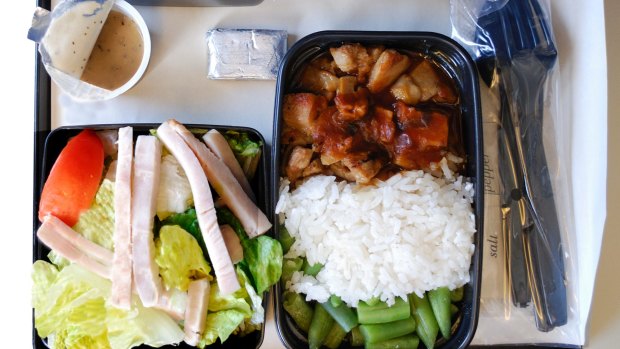This was published 6 years ago
Plane food: The number of calories consumed on the average flight revealed
By Gavin Haines
Just when you thought plane food couldn't get any worse, research arrives to prove otherwise.
According to a new book, Gastrophysics: The New Science of Eating, meals served at altitude not only taste terrible, but are often more calorific and, perversely, more desirable than dishes served on the ground.
There is a science behind this, explains the book's author, Professor Charles Spence.

Calorie count: There's a reason why airlines don't tell you what's in your in-flight meal.Credit: iStock
"The lower cabin air pressure, dry cabin air and the loud engine noise all contribute to our inability to taste and smell food and drink," he said.
"[Therefore] the food we consume needs 20-30 per cent more sugar and salt to make it taste like it would on the ground."
Perhaps this is why airlines won't tell you how healthy their food is.
It gets worse: according to Professor Spence, a lecturer at Oxford University, there are other factors at play which conspire to deliver us to our destination carrying more weight than we would want.
"Next, there is the boredom," he said. "With nothing else to do, food becomes an appealing distraction. And when it is being offered for free it will be even harder to resist."
Even the in-flight entertainment can affect our consumption, by distracting us from our full stomachs.
"Another really big problem is the movie or television you watch," said Professor Spence. "It is not uncommon to find people eating as much a third more food with the TV on."
See also: Which airlines have the best food?
So what's the damage? Well, in his book, Professor Spence cites research which suggests that the average Briton consumes nearly twice the recommended daily intake of calories travelling to their destinations.
"It has been estimated," he wrote, "that the British consume more than 3400 calories between their check-in at the airport and their arrival at their destination."
A fry-up and a couple of pints in the terminal would certainly help nudge passengers towards that figure, but the main reason for this sky-high calorie count is the plane food.
Some airlines have looked at novel ways of making their cuisine taste better at altitude, such as serving dishes that trigger our unami tastebuds, like curries.
"More often than not, though, the airlines have opted to load the food they serve with even more sugar and salt, to enhance the flavour," said Professor Spence. "No surprise, therefore, that the food served these days isn't the healthiest."
Another tactic used by airlines has been to enlist the services of celebrity chefs. However, according to Professor Spence, this is a largely futile endeavour.
"I have yet to see any evidence to support the claim that the chef's interventions… actually led to a significant increase in passenger satisfaction," he wrote.
Gordon Ramsay appears to agree. After years working for Singapore Airlines, the celebrity chef claimed, in his usual potty-mouthed manner, that he would never eat plane food again.
"I worked for airlines for 10 years, so I know where this food's been and where it goes, and how long it took before it got on board," he told Refinery29. "There's no f****** way I eat on planes."
See also: Qantas served me the best airline dish ever
Tips for staying healthy on a flight
Travel with alcohol hand gel
...or antibacterial hand wipes, and use them before eating or handling food, and after going to the toilet (in addition to washing your hands).
You're just as likely to come into contact with germs on the way to the airport, and identifies dirty hands as the biggest trouble-maker, Dr Dawood said.
"For most people, a journey affords a host of other opportunities to acquire infection: in the taxi to the airport, on buses and trains, in crowded departure lounges, and plenty of close contact with people at your destination," he advised a reader who developed an illness after a long-haul flight.
"Those in-flight snacks should be avoided until you have had a chance to wash your hands."
Use a nasal saline spray
...or a product such as Vicks First Defence, to keep the nasal passages moist during a long flight, reducing the risk of airborne disease transmission.
Consider the source of any food or water you are offered on board very carefully.
On flights originating from places with poor hygiene, stick to bottled water and don't eat food unless you are convinced of its safety.
Stay hydrated
Immobility in a cramped seated position causes fluid shifts within the body, moving fluid out of circulation and into the tissues (evident for example as ankle swelling during lengthy flights). Most people should be drinking the equivalent of a litre of water during a six to eight hour flight in order to remain well hydrated, but most people drink much less during a flight than they would on the ground. Consequences include headache, fatigue, constipation, and in women, an increased risk of cystitis.
Sign up for the Traveller newsletter
The latest travel news, tips and inspiration delivered to your inbox. Sign up now.